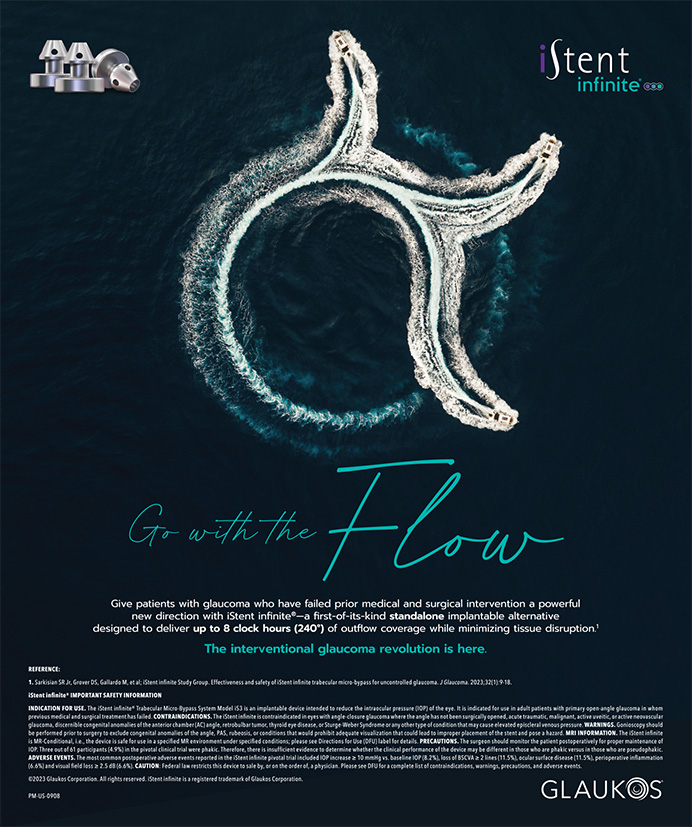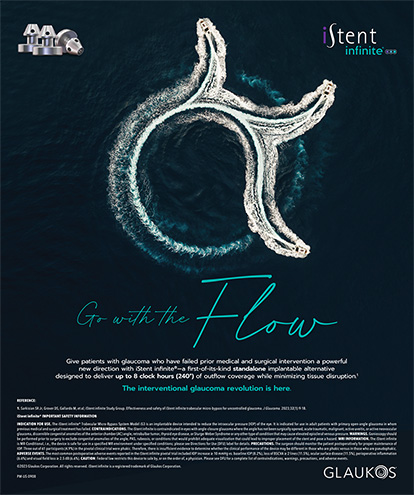Complications Management | Sep 2005
A Sudden Collapse of the Anterior Chamber
Garry P. Condon, MD; Richard S. Hoffman, MD; Alan N. Carlson, MD; and Warren E. Hill, MD, FACS
GARRY P. CONDON, MD
This dramatic and rather nauseating depiction of a sudden loss of the anterior chamber with inversion of the cornea indicates that aspiration completely outstripped available infusion. In my experience, this problem is nearly always because the infusion line has separated from the phaco handpiece while the surgeon is in foot position 2 or 3 (any aspiration mode). The complication is most dramatic and rapid in appearance if it occurs during the high aspiration/flow rates often used during nuclear quadrant removal, as seen in Figure 1. Other possible causes are a kink in the infusion tubing or an inadvertent emptying of the infusion bottle while in aspiration mode. Postocclusion surge produces a much less severe, transient reduction in the anterior chamber's volume and is less common with newer phaco equipment.
I would immediately go to foot position 1 to avoid further aspiration damage and a wound burn. After carefully removing the second instrument, I would expeditiously refill the anterior chamber with BSS via the sideport. I am reluctant to have my surgical technician attempt to reconnect the infusion while the phaco tip is in the eye. I would remove the phaco tip and add a dispersive viscoelastic to recoat the corneal endothelium before proceeding. Conversely, the phaco tip could be slowly withdrawn, leaving the second instrument undisturbed until I have refilled the anterior chamber with BSS and viscoelastic. The problem can effectively be avoided if the OR staff has been instructed to keep the flanges of the I/A tubing from overlapping, a situation that reduces the security of the connection to the handpiece.
RICHARD S. HOFFMAN, MD
A sudden collapse of the anterior chamber associated with involution and folds of the cornea suggests hypotony as the cause. Low IOP during phacoemulsification results from an imbalance of fluid mechanics (ie, the flow exiting the eye exceeds the infusion into the eye). Assuming that the incisions are essentially watertight and there have been no sudden, inadvertent changes in the aspiration and vacuum settings on the machine midway through the procedure, a lack of infusion is the most likely culprit. Changing the foot pedal from position 3 to 1 will verify or disprove this hypothesis. If excessive aspiration was the cause, the chamber should reform with the cessation of aspiration while infusion continues. If the situation remains unchanged in foot position 1, then the surgeon should suspect a deficit of infusion. This problem could result from an empty irrigating bottle, the kinking of the infusion line, or the loosening of the infusion adaptor from the phaco handpiece. The last scenario could be verified by the associated “wet calf” sign.
After moving the foot pedal into position 1 or continuous flow, I would gently remove the chopper and keep the phaco needle in the eye. I would then reform the anterior chamber with a dispersive ophthalmic viscosurgical device injected through the paracentesis to protect the corneal endothelium from nuclear-fragment trauma. After reformation of the anterior chamber, I could safely remove the phaco needle as well as verify and rectify the lack of infusion.
ALAN N. CARLSON, MD
This patient appears to be experiencing acute shallowing of the anterior chamber with corneal folds following a chopping maneuver in the midst of otherwise uncomplicated phaco surgery. Given the history and Figure 1, it appears that this loss of chamber depth is due to excessive leakage from a gaping wound rather than inadequate infusion. This conclusion is confirmed by the reduced distance between the two instruments (visible upon comparing Figure 1A and B), and it is further supported by a clear corneal wound (or at least a groove) that appears to be larger than necessary. The arrows on Figure 1B show folds that are probably caused by a combination of mechanical forces produced by instrumentation and made even more apparent by hypotony.
Treatment begins with a prompt recognition of the problem and an immediate backing off from foot pedal position 2 to 1, which will allow fluid irrigation to continue without aspiration. Simultaneously, the surgeon should reposition both instruments to reduce compressive forces and wound gape in an effort to reestablish the chamber's depth and reduce the risk of permanent injury to the corneal endothelium, iris, or posterior capsule. It is important to maintain infusion and, if necessary, increase the bottle's height while repositioning the instrumentation in order to minimize wound gaping and fluid leakage.
If the chamber's depth is still a problem, one might consider removing the second instrument completely while maintaining infusion and then assessing the impact this step has on the chamber's depth and fluid leakage. In eyes with a propensity for shallow chambers due to excessive leakage through the paracentesis site during the use of a second instrument, the chamber's depth often improves after the surgeon switches to a one-handed technique to reduce this leakage. In an extreme case involving a large, poorly constructed wound, suturing it closed and creating a new, smaller incision can help. Sutures should not be necessary here, however.
Fortunately, the shallow anterior chamber in this case does not appear to be due to a potentially more serious complication such as suprachoroidal hemorrhage or aqueous misdirection related to a loss of capsular or zonular integrity. Nevertheless, one must ensure that scleral collapse secondary to squeezed eyelids or a poorly positioned speculum is not producing the problem.
In eyes with a shallow anterior chamber due to inadequate infusion rather than excessive leakage, the surgeon must make sure that the infusion bottle is not empty and that it is at an adequate height relative to that of the patient's eye. Also important is making sure that a vacuum-fluid lock has not developed within the infusion bottle, a situation requiring an air vent. Moreover, the surgeon should verify that the infusion line is not obstructed, inappropriately clamped, leaking, or perhaps separated from the handpiece. If necessary, one should check the handpiece for malfunction. On occasion, an unusually tight wound can cause compression and collapse of the infusion sleeve, thereby intermittently blocking fluid inflow.
Although problems related to fluidics are common, surgeons may not immediately recognize them or understand their etiology and mechanism. An awareness of the important balance between infusion and aspiration includes correcting excessive leakage in this case to avoid further injury due to mechanical and thermal trauma.
WARREN E. HILL, MD, FACS
The surgeon is midway through phacoemulsification, and the appearance of the eye suddenly changes. The anterior chamber has collapsed while the surgeon is in foot position 3.
I would immediately switch to foot position 1 to maintain infusion without aspiration. If this move did not quickly reform the anterior chamber, I would protect the endothelium by injecting viscoelastic through the sideport incision without removing the phaco needle.
With the anterior chamber stabilized, I would turn my attention to anything that might disrupt the balance between infusion and aspiration. It might be something as simple as a mistaken lowering of the irrigation bottle during phacoemulsification, a leaking wound, a tight incision, or an unusual angle to the phaco handpiece that distorts the corneal wound or compresses the phaco needle's sleeve. Among other possibilities, the irrigating fluid may have run out due to excessive priming before the start of the case, or the tubing may have become inadvertently kinked or disconnected from the phaco handpiece. It is usually easy to identify and quickly correct the cause of insufficient infusion.
Aside from damage to the corneal endothelium due to a collapsed chamber, a failure to recognize reduced infusion immediately and to continue in foot position 3 could rapidly result in an incisional burn with distortion. Figure 1 shows the phaco needle pressed directly against the irrigation sleeve, a setup for incisional burn if phacoemulsification continued even briefly with infusion reduced to the point of ocular hypotony. To preclude the possibility of incisional burns, my colleagues and I keep the irrigation solution in the OR's refrigerator, which is approximately 40°F. Thus, even a 60°F rise in the temperature of the fluid within the irrigating sleeve would therefore only be slightly above body temperature. We have used this method for more than 1 decade with no incisional burns recorded to date.
Section Editors Robert J. Cionni, MD; Michael Snyder, MD; and Robert H. Osher, MD, are cataract specialists at the Cincinnati Eye Institute in Ohio. They may be reached at (513) 984-5133; rcionni@cincinnatieye.com.
Alan N. Carlson, MD, is Chief of the Corneal and Refractive Surgery Service at Duke University Eye Center in Durham, North Carolina. He states that he holds no financial interest in the product or company mentioned herein. Dr. Carlson may be reached at (919) 684-5769; alan.carlson@duke.edu.
Garry P. Condon, MD, is Clinical Associate Professor for the Department of Ophthalmology at Allegheny General Hospital in Pittsburgh. He is on the Speaker's Bureau for Alcon Laboratories, Inc., and Merck & Co., Inc. Dr. Condon may be reached at (412) 359-6298; garlinda@usaor.net.
Warren E. Hill, MD, FACS, is Medical Director of East Valley Ophthalmology in Mesa, Arizona. He has served as a consultant in the area of IOL power mathematics for Alcon Laboratories, Inc., but states that he holds no direct financial interest in the product mentioned herein. Dr. Hill may be reached at (480) 981-6111;
hill@doctor-hill.com.
Richard S. Hoffman, MD, is Clinical Associate Professor of Ophthalmology at the Casey Eye Institute, Oregon Health & Science University, and he is in private practice at Drs. Fine, Hoffman, & Packer in Eugene, Oregon. He states that he holds no financial interest in the product or company mentioned herein. Dr. Hoffman may be reached at (541) 687-2110; rshoffman@finemd.com.


